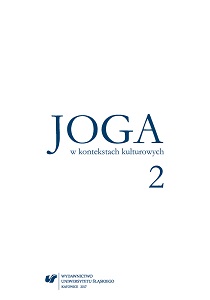O mudrze khećari i pierwotnym obliczu hathajogi
About the khećari mudra and the original image of the hathayoga
Author(s): Dagmara Wasilewska
Subject(s): Social Sciences, Fine Arts / Performing Arts, Sociology, Health and medicine and law
Published by: Wydawnictwo Uniwersytetu Śląskiego
Keywords: the history of hathayoga; the practice of the mudras; khećari
Summary/Abstract: At the beginning hathayoga was an ascetic discipline which was not associated with any specific school of philosophy. The oldest forms of hathayoga which appear in textsconstituted practices which might be referred to collectively as mudras, literally “seals” i.e. physical techniques by means of which the first hathayogins controlled the life forces in the form of breath, kundalini and semen. One of the more important mudras of this original canon was the khećari mudra, which enabled the apprentice to calm his mind, to stop the life substance identified with the nectar of immortality (amrita) in his body and/or to relish this nectar, which was supposed to ensure health and immortality and induce him into a state of profound mystical integration.The article presents the early yogic practice of khećari mudra and on the basis of this example indicates the particular features and the purposes of the early hathayoga which included, among other things and apart the attainment of supernatural powers (siddhi) and corporal immortality – liberation. The article also directs the attention of the reader to the misunderstandings, present in the social consciousness of the West, in reference to the nature of hathayoga and its formative influences, among other things, the belief about its purely physical nature, and the act of putting hathayoga in opposition toward Patanjali’s yoga or ascribing to hathayoga an exclusively auxiliary role in reference to rajayoga, for the most recent publications of such researchers as James Mallinson, Jason Birch or Mark Singleton cast a completely new light on the history and the development of this branch of yoga.
Book: Joga w kontekstach kulturowych 2
- Page Range: 17-36
- Page Count: 20
- Publication Year: 2017
- Language: Polish
- Content File-PDF

